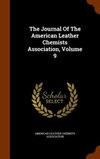通过实验与分子动力学模拟相结合研究中性盐与胶原蛋白的相互作用机理
IF 0.5
4区 工程技术
Q4 CHEMISTRY, APPLIED
Journal of The American Leather Chemists Association
Pub Date : 2023-07-03
DOI:10.34314/jalca.v118i7.7855
引用次数: 0
摘要
盐对皮革胶原蛋白的影响在皮革制造中具有重要意义。然而,中性盐与胶原蛋白之间的相互作用尚不明确,因为从宏观上很难直接观察到皮革胶原蛋白的微观相互作用。本研究采用典型的中性盐(NaCl、CaCl2 和 Na2SO4)体系中的胶原蛋白溶液,通过实验与分子动力学(MD)模拟相结合的方法,探索中性盐与胶原蛋白之间的相互作用机理。芘荧光测量、动态光散射、原子力显微镜和等电点的结果表明,不同中性盐与胶原蛋白相互作用的变化伴随着胶原蛋白理化性质的变化。MD 模拟进一步揭示了中性盐与胶原蛋白在分子水平上相互作用机制的详细信息。胶原蛋白-盐模型盒的非键能计算结果表明,不同盐类与胶原蛋白分子的静电相互作用顺序为 CaCl2> Na2SO4> NaCl。对可视化构象和径向分布函数的分析表明,以 Ca2+ 为离子的 CaCl2 更倾向于与胶原蛋白形成分子内盐桥,而以 SO42 为离子的 Na2SO4 更有可能在胶原蛋白分子之间形成团块状盐桥。相比之下,以 Cl- 为离子的 NaCl 则分散在胶原模型周围,对胶原的影响要小得多。该研究阐述了典型中性盐与胶原蛋白的相互作用机理,有助于进一步了解和改进中性盐在皮革生产多个步骤中的应用。本文章由计算机程序翻译,如有差异,请以英文原文为准。
Study on Interaction Mechanism between Neutral Salts and Collagen by Combining Experiments with Molecular Dynamics Simulation
The effect of salt on the collagen of hide/skin is of great significance in leather-making. However, the interaction between neutral salts and collagen has not been clear, since the microscopic interaction is hard to be observed directly from the macro level of hide/skin collagen. In this study, the collagen solutions in the typical neutral salts (NaCl, CaCl2, and Na2SO4) systems were used to explore the interaction mechanism between neutral salts and collagen via combining experiments with molecular dynamics (MD) simulation. The results of fluorescence measurements of pyrene, dynamic light scattering, atomic force microscopy, and isoelectric point suggested that the variation of the interaction between different neutral salts and collagen was accompanied with the changes in physicochemical properties of collagen. MD simulation further revealed more detailed information on the interaction mechanism between neutral salts and collagen at the molecular level. The computational results of non-bond energy of the collagen-salt model boxes indicated that the electrostatic interactions of different salts with collagen molecules had the order of CaCl2> Na2SO4> NaCl. The analyses of the visualized conformation and the radial distribution functions showed that CaCl2 with Ca2+ as contributing ion tended to form intramolecular salt bridges with collagen, while Na2SO4 with SO42-as contributing ion more likely formed salt bridges between collagen molecules in the shape of agglomerates. In contrast, NaCl with Cl-as contributing ion was scattered around the collagen models, and its effect on collagen was much smaller. The study elaborated the interaction mechanism of typical neutral salts and collagen to be helpful for further understanding and improving the use of neutral salts in many steps involved in leather production.
求助全文
通过发布文献求助,成功后即可免费获取论文全文。
去求助
来源期刊

Journal of The American Leather Chemists Association
工程技术-材料科学:纺织
CiteScore
1.30
自引率
33.30%
发文量
29
审稿时长
3 months
期刊介绍:
The Journal of the American Leather Chemists Association publishes manuscripts on all aspects of leather science, engineering, technology, and economics, and will consider related subjects that address concerns of the industry. Examples: hide/skin quality or utilization, leather production methods/equipment, tanning materials/leather chemicals, new and improved leathers, collagen studies, leather by-products, impacts of changes in leather products industries, process efficiency, sustainability, regulatory, safety, environmental, tannery waste management and industry economics.
 求助内容:
求助内容: 应助结果提醒方式:
应助结果提醒方式:


